
ASUS Maximus VI Gene Motherboard Review
Introduction

With so many great ATX motherboards being launched recently for Z87 chipset, it's easy to forget mATX boards like the Maximus VI Gene that is targeted at both overclockers and gamers. You would expect a mATX board like this to come with only a few SATAIII ports but ASUS has equipped this bad boy with eight SATAIII ports, sixteen USB ports (8x USB 3.0 and 8 USB 2.0), a ridiculous amount of headers especially for fans, amazing built in sound quality and much more.
The Z87 Maximus VI Gene sports the black and red color scheme that you would expect from the ROG series. The brand new AI Suite III which ASUS has improved quite a lot from the previous version makes overclocking super easy. It literally takes a single mouse click to for AI Suite III to find the best overclock for your computer.
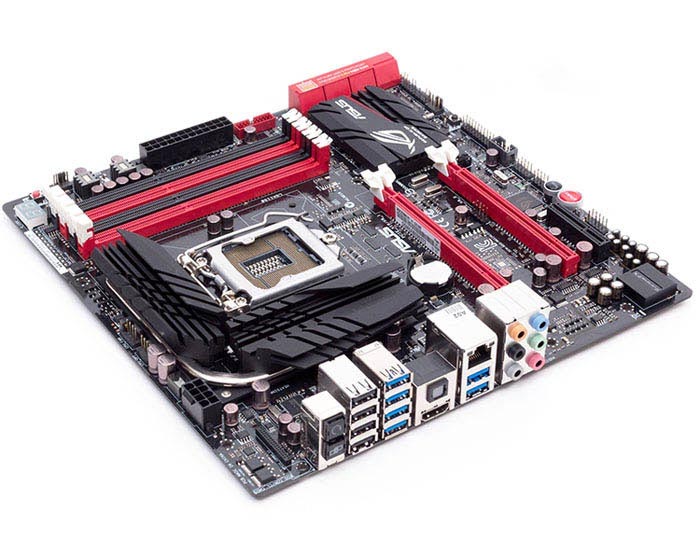
The Z87 Maximus VI Gene comes with a whopping eight SATAIII ports and they are all 6Gb/s ports. Six of those SATA III ports are from the Z87 chipset and two of those are from the ASMedia 1061 controller. When using a M.2 slot on mPCIe Combo II, SATA port 5 will be disabled.
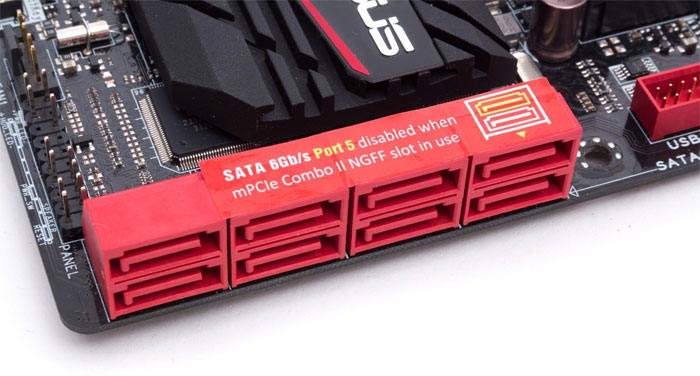
The motherboard is SLI and Crossfire ready so you can stick two of your favorite cards in there and get awesome performance (they won't run at full x16 but instead at x8 which is still more than enough). You also have sixteen USB ports; eight are USB 3.0 ports via the Z87 chipset and eight more from ASMedia 1042 controller.
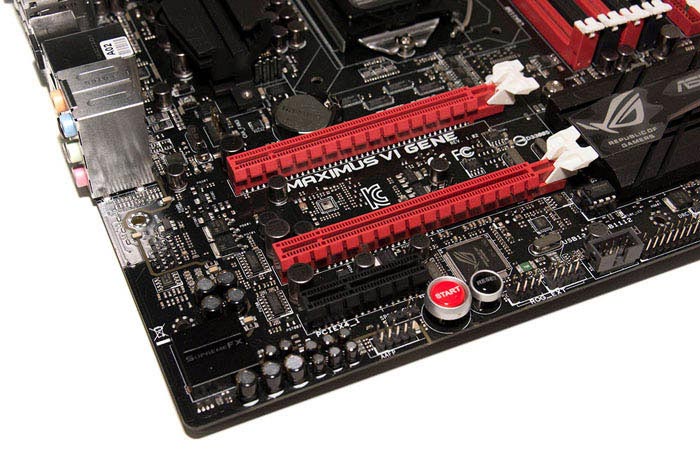
It comes with a total of four PCI-Express slots. Two PCIe 3.0 x16 slots, one PCIe x4 slot and one mini-PCIe 2.0 x1 port. The board supports full x16 bandwidth but only with a single card. If you want to run dual GPUs, it will run at x8/x8 and triple card setup isn't possible.
Also, something to note about the Z87 Maximus VI Gene is that there are no PCI slots which might disappoint some people. I personally like that it doesn't have any PCI slots because it can take up precious space in the motherboard and they have become so outdated and slow nowadays.
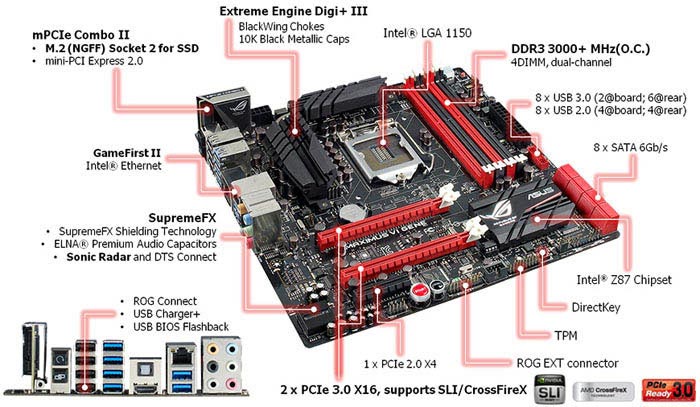
The overall layout of the motherboard is excellent and the ROG color scheme looks attractive on the black PCB. There's plenty of room around the socket region to install even some of today's largest CPU coolers like the Noctua NH-D14. It comes with a stainless steel back I/O for great protection and extended motherboard lifespan. The build quality of the motherboard feels very sturdy when holding and very durable like with any ASUS motherboard.
The board also offers a massive 8+2-phase power design for high overclocking, and best of all, there are 10K Black Metallic Capacitors rated for 10,000 hours at 105C. The 10K Black Metallic capacitors last five times longer and deliver 20% greater extreme temperature endurance than generic solid state capacitors. The Z87 Maximus VI Gene uses NexFET MOSFETs that can handle up to 90% efficiency under normal operation and better durability than the standard MOSFETs.
The black metal heatsinks on the VRMs look great and you can feel that they are made with high quality materials. All of these great design features make the motherboard very attractive. On the back of the motherboard you will see that there are a few backplates where the VRMs are and this is to protect the circuitry and help with dissipating the heat. The board comes with a 3 year warranty.
Technical Specifications
| Asus Maximus VI Gene Specs | |
|---|---|
| CPU: | Intel Socket 1150 Supports Intel 22 nm CPU Supports Intel Turbo Boost Technology 2.0 |
| Chipset: | Intel Z87 |
| Memory: | 4 x DIMM, Max. 32GB Up To DDR3 3000 MHz (O.C.) Non-ECC, Un-buffered Memory |
| Graphic: | Supports HDMI with max. resolution 4K @ 24 Hz / 2K @ 60 Hz Supports Intel HD Graphics Supports up to 3 displays simultaneously |
| Multi-GPU Support: | NVIDIA Quad-GPU SLI Technology AMD Quad-GPU CrossFireX Technology |
| Expansion Slots: | 2 x PCIe 3.0/2.0 x16 (x16 or dual x8) 1 x PCIe 2.0 x4 1 x mini-PCIe 2.0 x1 |
| Storage: | 6 x SATA 6Gb/s port(s) 1 x M.2 (NGFF) Socket 2 on mPCIe Combo II expansion card(s) Support M.2 (NGFF) Type 2242 SSD card (22mm x 42mm) ASMedia ASM1061 controller 2 x SATA 6Gb/s port(s) |
| LAN: | Intel I217V, 1 x Gigabit LAN Controller(s) |
| Audio: | ROG SupremeFX 8-Channel High Definition Audio CODEC - High quality 115 dB SNR stereo playback output (Line-out at rear) and 104 dB SNR recording input (Line-in) Audio Feature - SupremeFX Shielding Technology - ELNA premium audio capacitors - Blu-ray audio layer Content Protection - Sonic Radar - DTS Connect - Optical S/PDIF out port(s) at back panel |
| USB Ports: | 4 x USB 3.0 port(s) (2 at back panel, blue, 2 at mid-board) 8 x USB 2.0 port(s) (4 at back panel, black, 4 at mid-board) 4 x USB 3.0 port(s) (4 at back panel, blue) |
| ROG Exclusive Features: | mPCIe Combo II (mPCIe/M.2 combo card) Extreme Engine Digi+ III : - 8 + 2 phase power design - NexFET Power Block MOSFET - 60A BlackWing Chokes - 10K Black Metallic Capacitors ProbeIt UEFI BIOS features : - ROG BIOS Print - GPU.DIMM Post - Tweakers' Paradise - ROG SSD Secure Erase ROG RAMDisk GameFirst II Extreme Tweaker |
| Back I/O Ports: | 1 x HDMI 1 x LAN (RJ45) port(s) 6 x USB 3.0 (blue) 4 x USB 2.0 1 x Optical S/PDIF out 6 x Audio jack(s) 1 x Clear CMOS button(s) 1 x ROG Connect On/ Off switch(es) |
| Internal I/O Ports: | 1 x USB 3.0 connector(s) support(s) additional 2 USB 3.0 port(s) 2 x USB 2.0 connector(s) support(s) additional 4 USB 2.0 port(s) 1 x TPM connector(s) 8 x SATA 6Gb/s connector(s) 1 x CPU Fan connector(s) 1 x CPU OPT Fan connector(s) 3 x Chassis Fan connector(s) 1 x S/PDIF out header(s) 1 x 8-pin EATX 12 V Power connector 1 x 24-pin EATX Power connector(s) 1 x Front panel audio connector(s) (AAFP) 1 x System panel(s) 1 x DirectKey Button(s) 1 x DRCT header(s) 1 x MemOK! button(s) 10 x ProbeIt Measurement Points 1 x LN2 Mode header(s) 1 x Power-on button(s) 1 x Reset button(s) 1 x ROG extension (ROG_EXT) header(s) 1 x mPCIe Combo II connector(s) |
| Accessories: | User's manual I/O Shield 6 x SATA 6Gb/s cable(s) 1 x SLI bridge(s) 1 x Q-connector(s) (2 in 1) 1 x 12 in 1 ROG Cable Label(s) 1 x mPCIe Combo II expansion card(s) 1 x ROG Door Hanger(s) |
| BIOS: | 64 Mb Flash ROM, UEFI AMI BIOS, ASUS EZ Flash 2 |
| Form Factor: | mATX Form Factor 9.6 inch x 9.6 inch ( 24.4 cm x 24.4 cm ) |
Packaging & Accessories
Let's start off with the packaging because that's the first thing we'll see when we receive the product. The retail packaging feels sturdy and is overall great and also very attractive. Everything that you need to know about the motherboard is presented right in front of you. Before, we were used to seeing Asus's packages with the typical blue color scheme but this time Asus has gone with a black and gold color scheme which looks absolutely fantastic.
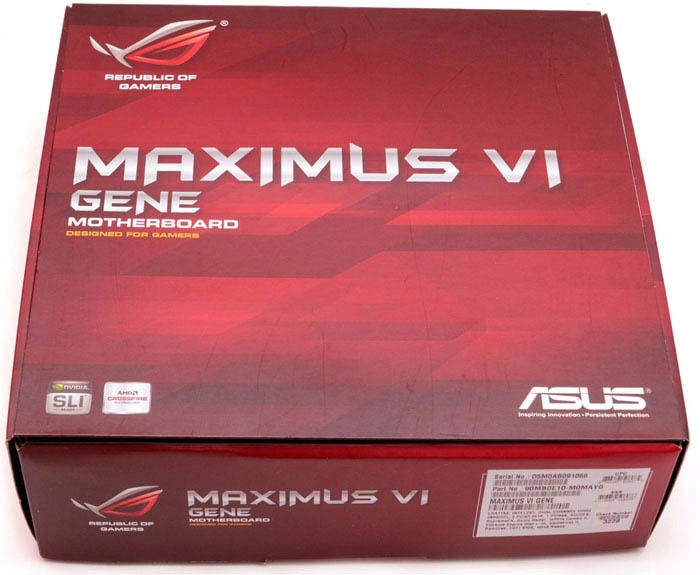
In the center of the front cover, we have the name of the motherboard written in big white text. At the top left, we have the Republic of Gaming logo and on the bottom left we have the SLI and Crossfire sticker. There's not a whole lot of stuff on the front cover so let's move on to the back because that's where most of the information is.
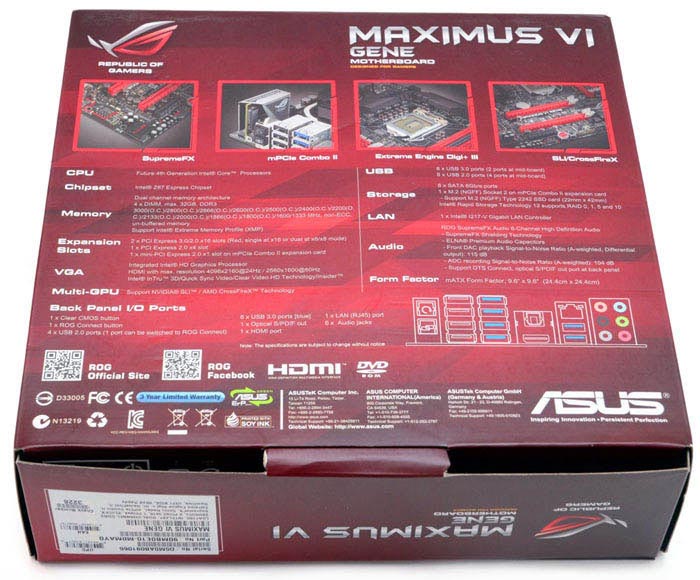
On the back cover, we have four little square boxes with images that show some of the features that come with this motherboard. There's the SupremeFX which if you remember was once a discrete audio card but it's now integrated into the motherboard so you can expect amazing sound quality from this board. It uses ELNA premium Japan-made audio capacitors that provide immersive sound with exceptional clarity that is great for game effects and multimedia. There's the mPCIe Combo II feature and it can support socket M2 (NGFF) SSDs along with a Dual Band WiFi Bluetooth module. There's also the Extreme Engine Digi+III and that is an upgraded VRM system designed by ROG for Haswell processors that comes with all Maximus VI series motherboards. And the last one is SLI/CrossFireX which is pretty self-explanatory. Below these four little boxes, we have all specifications of the motherboard listed out.
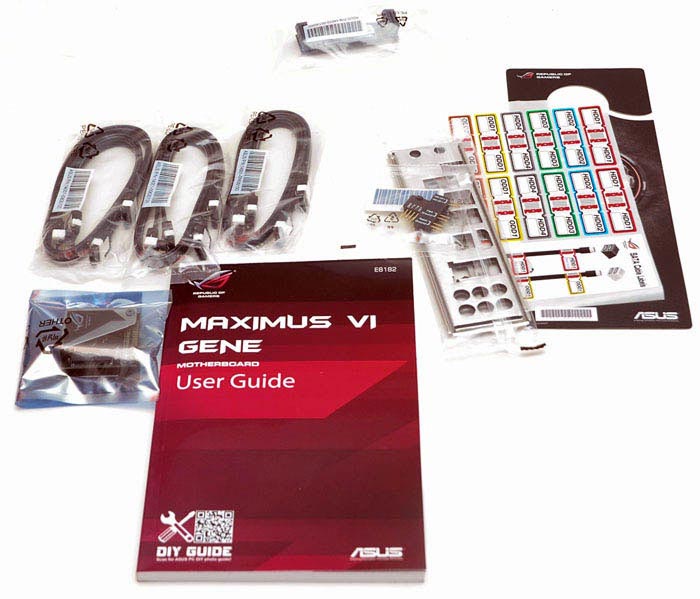
Here are all the accessories that you will find inside the box.
It comes with four DDR3 DIMM slots supporting up to 32GB of ram in dual channel mode and can even support ram up to 2800Mhz-3000Mhz
if you can overclock it. The motherboard comes with a debug LED which can be very useful if something goes wrong when installing a new
hardware. The LED display on the board will give you an error code which then you can use to look up what the problem is.
The LED display is always on and when there isn't an error, it displays the BIOS version. This feature can be quite handy when
troubleshooting new hardware and really easy to figure out what exactly is not working properly. Also, the southbridge
has two additional heatsinks with a small heatpipe in the middle of them.
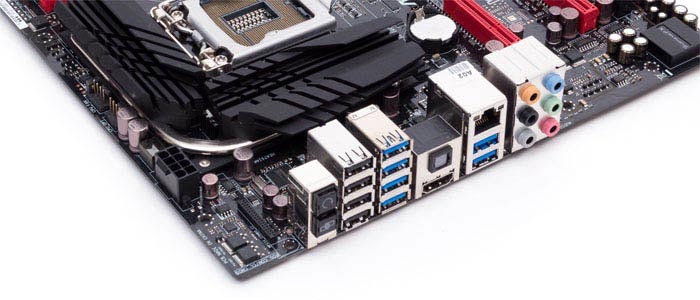
Back I/O Ports
* 1x ROG Connect Button
* 1x Clear CMOS Button
* HDMI Port
* LAN (RJ45) port
* 6x USB 3.0 (blue)
* 4x USB 2.0 (black)
* Optical S/PDIF out
* 6x Audio jack(s)
An excellent feature that Asus has implemented into their boards is the USB BIOS Flashback button.
You can use this to flash the BIOS without having to boot the system into the UEFI BIOS which makes it much easier.
There's no need to have a CPU, memory, or GPU installed in the motherboard to update your BIOS. You simply plug in a
USB drive with the correct BIOS file and press the button for 3 seconds until the integrated LED begins to flash.
AI Suite III
The brand new AI Suite III makes overclocking extremely easy even for first time users. With the new AI Suite III, you have pretty much control over your entire motherboard and when I say you have control over your entire motherboard, I really mean it. When using AI Suite III, you are presented with five sections at the top and each one does its specific thing. You have the option of putting your computer in power saving mode to reduce as much electricity as possible or set it to high performance to get the most out of your computer. You can customize your fan speeds for silent mode, automatically/manually overclock your CPU and many more which I'll explain into details below.
When you first open up AI Suit III, the first section that you will see is the 4-Way Optimization section and this deals mostly with automatic overclocking, optimizing fan speed and power savings options. At the bottom of this section, we can see our current CPU frequency, Dram frequency, the voltage for each core, temperature of the CPU/Motherboard and how fast each fan in your case is running at. Also, on the side you have four power saving modes, Auto, High Performance, Max Power Saving and Away Mode. This section will mostly display the settings your current components are running at; you can't really tweak anything here.
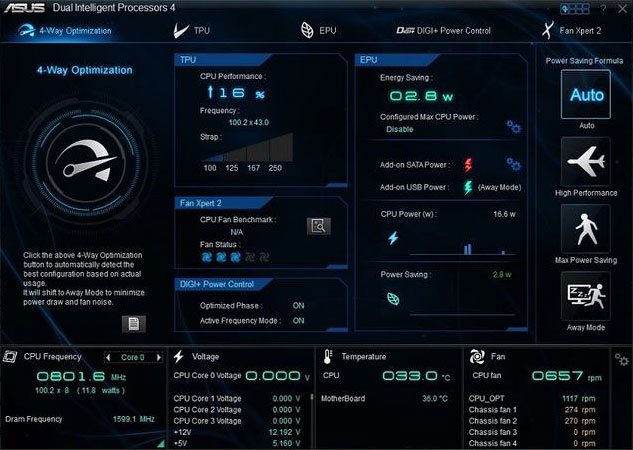
The next section of the AI Suite III is the TPU section and this is where you will be spending most of your time tweaking your CPU settings and overclocking it. Here we have adjustable settings for BCLK, CPU Ratio, CPU Cache Ratio, Voltages and CPU Cache. Overclocking has never been this easy and Asus has done a fantastic job at improving their software. I know some of the earlier versions of AI Suit had some glitches but it seems like Asus has fixed all of them. I remember one glitch in the earlier version of AI Suite where it would report a different CPU temperature than what it actually was in the BIOS but this seems fixed now.
There is a checkbox called Group Tuning that allows for adjusting each core individually or all cores at once. On the side of this section, we have four cylinders and each one represents each core of the CPU. You can also overclock each core differently if you like and it will show you the result using the cylinder. There is a subsection in the TPU section marked CPU Strap where you can change the CPU Strap to 100, 125, 167, and 250. At the bottom of this section, we can see the sensors for voltages, temperatures and fan speeds.
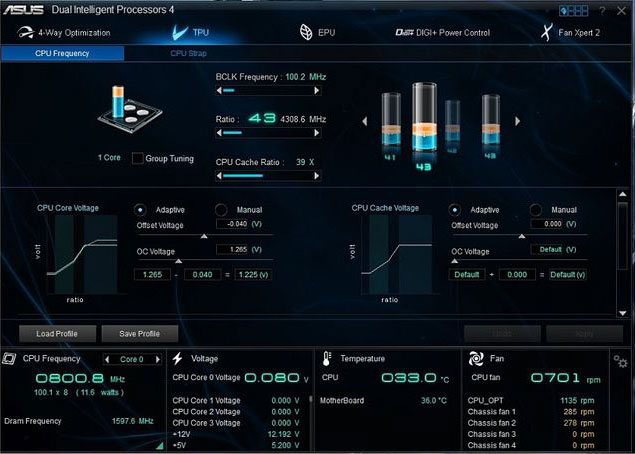
The third section is the EPU and this is specifically designed for power saving options. There are four subsections in the EPU section, Auto, High Performance, Max Power Saving and Away Mode. You have the option to set the voltage decrement to either auto or manual. You can also undervolt the CPU to conserve as much energy as possible. You can control your monitor sleep time, computer sleep, fan profiles and you can even turn off the USB controller power if a device is not attached to save as much energy as possible.
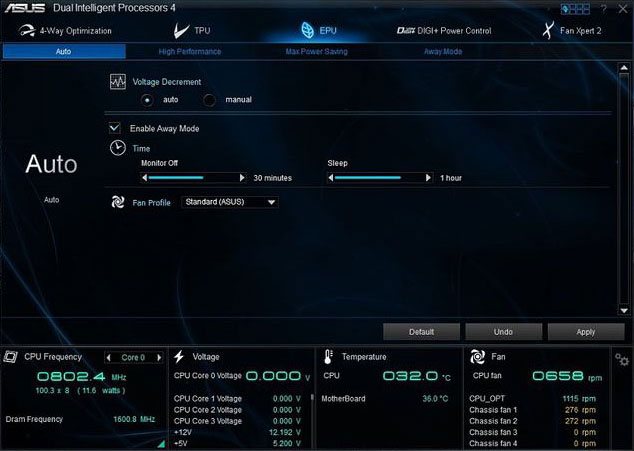
The fourth section is the Digi+Power Control and here you have two subsections, one for CPU and for RAM. The CPU section contains settings for load-line calibration, CPU Power Phase Control which can be set to either: Standard, Optimized, Extreme or Manual Adjustment. You also have CPU Current Capability, CPU Power Thermal Control, Voltage Frequency, CPU Power Duty Control and Active Frequency Mode which can be set to either OFF or ON. There are so many options in this section that you can play around with and get awesome overclocks. The memory subsection has adjustable settings for DRAM Current Capability, DRAM Voltage Frequency and DRAM power phase control. You can overclock your RAM with literally one mouse click and you don't have to constantly reboot into BIOS and keep tweaking the settings.
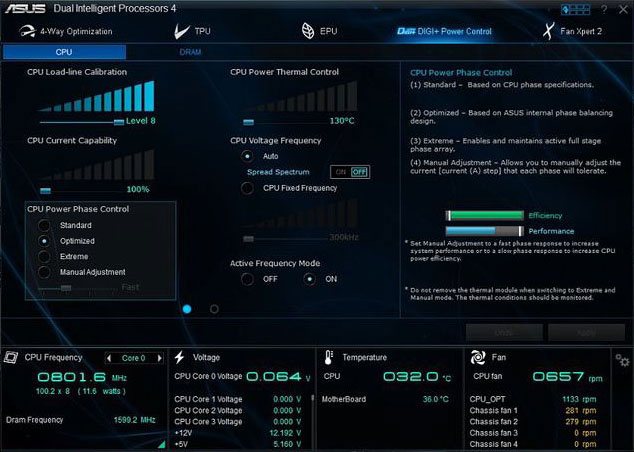
The fifth section is the Fan Xpert 2 and this is probably my favourite feature of the AI Suite III because it allows you full much control over every single fan in your case, from the CPU fan to each individual case fans. You have four profiles to choose from when you click the Fan Xpert 2 section, Silent, Standard, Turbo and Full Speed. You can set the fan in `silent' mode if you are doing light tasks such as watching YouTube videos or browsing the internet and you won't even hear the computer running. If you are going to be playing intensive games such as BF3, Crysis 3 or Metro LL then consider choosing a different fan profile.
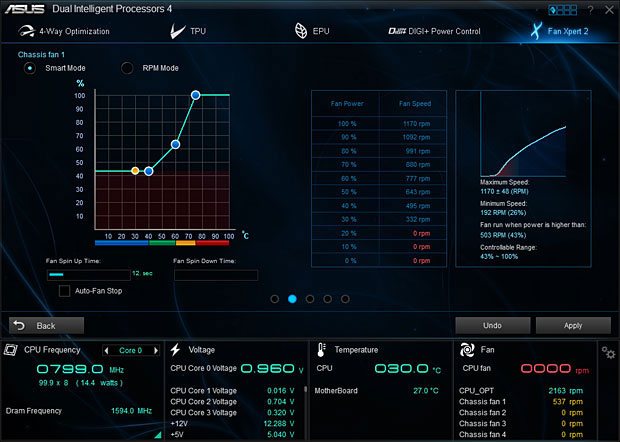
Test Setup & Methodology & Boot Time
| Test Setup | |
|---|---|
| Processor: | Intel i7 4770K 3.5 GHz (3.9 GHz Turbo) | Heatsink: | Noctua NH-U14S | Thermal Compound: | Noctua NT-H1 |
| RAM: | Kingston HyperX 8GB @ 1866 MHz |
| Graphics Card: | EVGA GTX 680 |
| Storage: | Samsung 840 Pro 256GB |
| Power Supply: | Antec Earth Watts 650W |
| Case: | Antec Nine Hundred |
| OS: | Windows 7 64Bit |
| Motherboards: | Asus Z87-Pro Asus Maximus VI Hero Asus Maximus VI Gene Gigabyte Z87X-UD3H MSI Z87-GD65 Gaming |
| Benchmarks | |
|---|---|
| System Benchmarks: | Cinebench 11.5 7-Zip wPrime 1024M SuperPi 32M CrystalDiskMark |
All testing is done on a clean Windows 7 Ultimate SP1 64bit on the Samsung 840 Pro 256GB SSD and nothing running in the background. Power consumption was tested on the system as a whole with a wall meter connected to the Antec Earth Watts 650W.
Idle power consumption was measured after leaving the computer in idle for 10 minutes. Load power consumption was measured after leaving the computer under full load for 10 minutes. The testing was conducted with motherboard power-saving options enabled because that's what most people will be running it at. All the games were tested at ultra settings at 1920x1080.
Moving on to the boot time, here we will be testing how long it takes to boot from the time when pressing the ON button to when Windows 7 starts loading. Each board was tested with and without fast-boot options enabled.
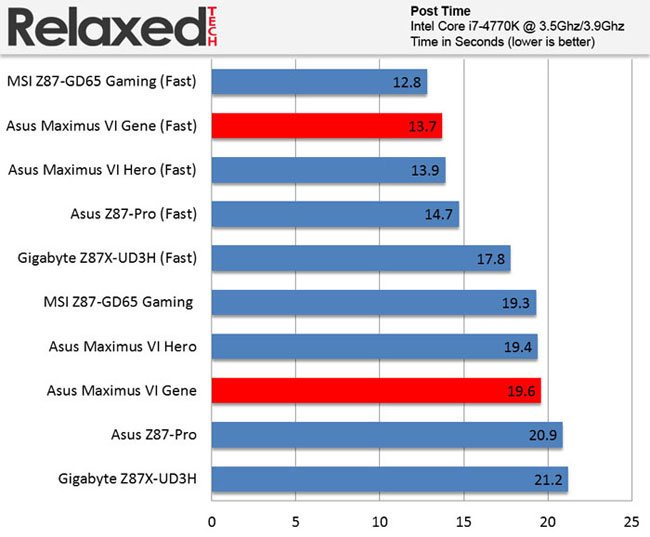
The MSI Z87-GD65 Gaming board takes the lead as the fastest Haswell booting board but not with much difference. There's only a 0.9 seconds difference between the two of them and it doesn't really mean anything in the real world.
Benchmark Results & Power Consumption
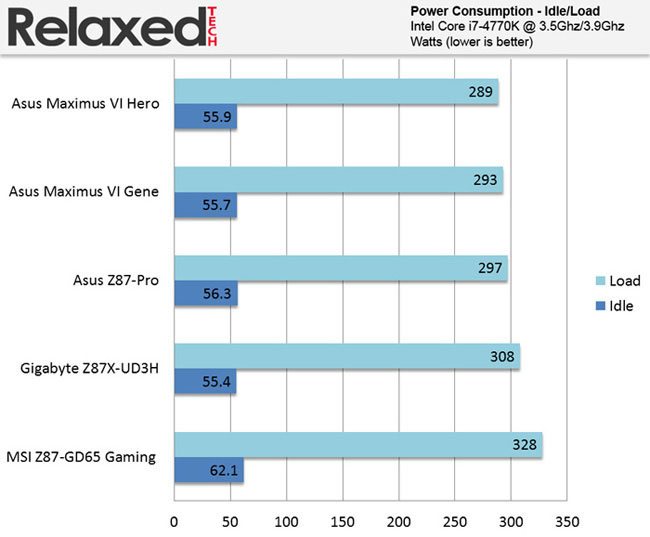
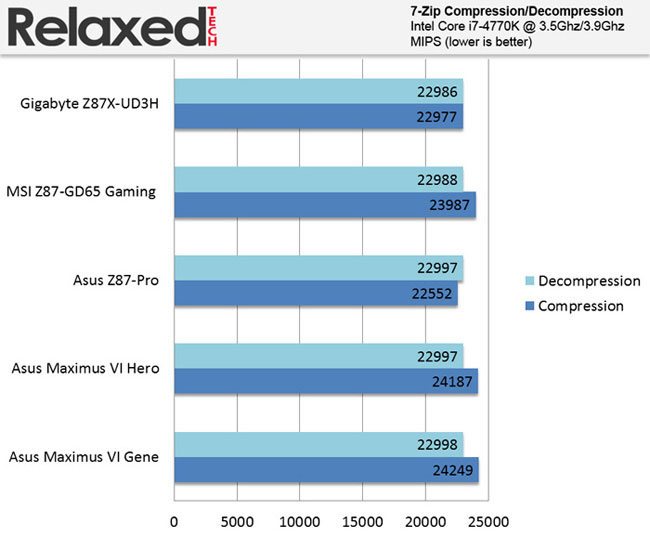
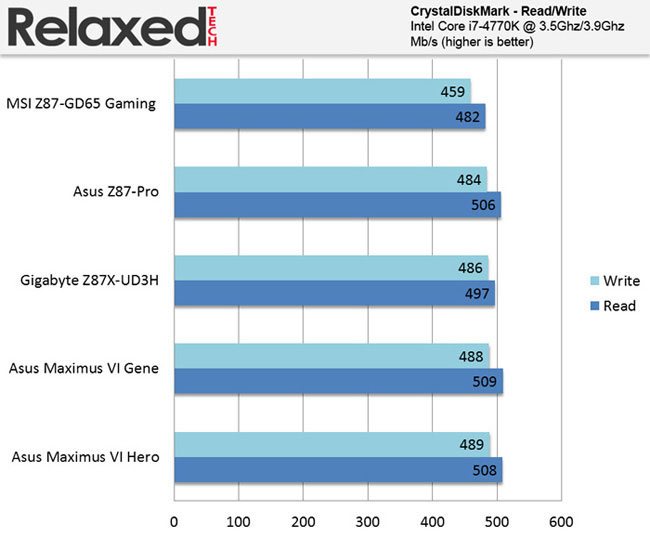
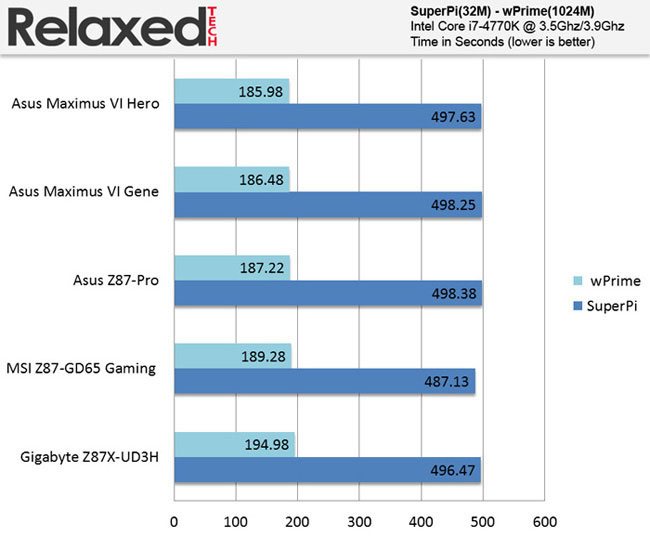
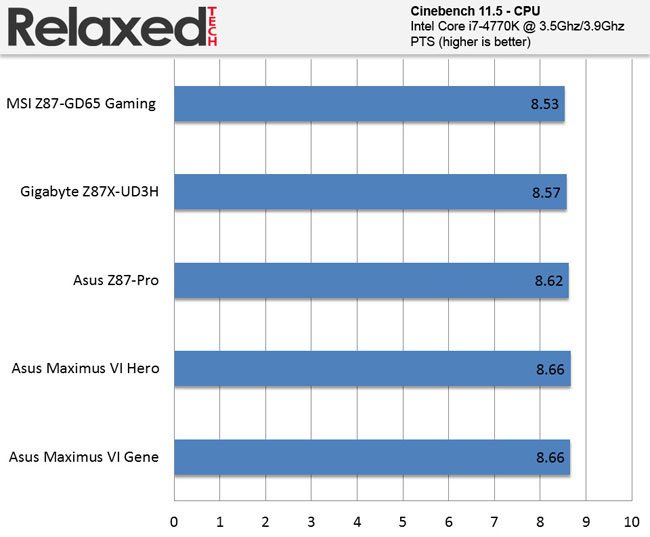
Conclusion
The Asus Z87 Maximus VI Gene is an excellent mATX motherboard that comes packed with a ton of amazing features, even more than some full ATX motherboards on the market if you ask me. If you are someone who's looking to build a small gaming machine that still has the overclocking potential of a full ATX board then the Z87 Maximus VI Gene might be the one you are looking for.
You cannot run triple card configuration with this motherboard because there are only two PCIe 3.0 slots but then again, very few people run more than one or two cards at the same time so it's not a deal breaker. The black and red color scheme looks very attractive and the board design looks top notch as you would expect from any ASUS motherboard.
Pros:
+ Outstanding Sound Quality (SupremeFX)
+ Comes Loaded With High-End Features
+ Outstanding UEFI BIOS
+ Overclocking Made Easy With AI Suite III
+ Fast USB 3.0 Speeds
+ Debug Display
+ mPCIe Slot M.2 (NGFF) Support
Cons:
- Pricey for a mATX motherboard
The new and improved UEFI BIOS is probably the best I have seen. It has everything you could ask for and then some.
The amount of SATAIII and USB 3.0 ports is mind-blowing. Boot times, SATAIII and USB 3.0
performance is excellent with this motherboard. SupremeFX delivers exceptional sound quality that makes the gaming experience much better now.
The ASUS Z87 Maximus VI Gene retails for $209.99 (Amazon) which might be a little steep for some of you but it also has an enormous amount of features that other mATXs boards don't have. This is a very attractive looking motherboard that doesn't disappoint in any area.
Final Score 9.0
